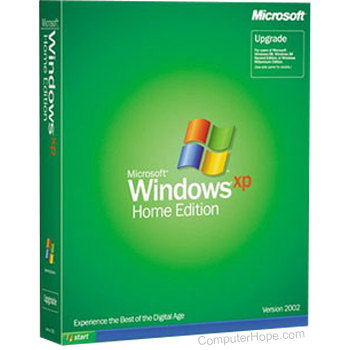Operating system

An operating system or OS is software installed on a computer’s hard drive that enables the computer hardware to communicate and operate with the computer software. Without a computer operating system, a computer and software programs would be useless. The picture shows Microsoft Windows XP in its original packaging.
With earlier computers, the user interacted with them using a command line interface, which required memorization of commands. Today, almost every computer uses a GUI (Graphical User Interface) operating system that’s easy to use and operate.
Table of Contents
ToggleWhat are the functions of an operating system?
There are many different functions and tasks an operating system performs on a computer; some of these include the following.
- Manage all of the computer hardware inside your computer and all of the connected peripherals. In some situations, the OS may need the assistance from additional device drivers.
- Manage all of the software and communication between software programs installed on the computer.
- Handle all of the data generated by the software.
Examples of computer operating systems
Below is a list of examples of different computer operating systems over the evolution of computers.
Microsoft Windows
Microsoft Windows is the most common and used operating system on computers today, with Microsoft Windows 10 being the most recently released Windows version. The operating system is used PC and IBM-compatible computers.
Apple macOS
With Apple computers, macOS is the primary operating system used with Apple desktop and laptop computers.
Linux
Linux is a free and open source operating system used with PC and IBM compatible computers. Because the operating system is open source, it is used to create many variants of Linux, including Ubuntu, Debian, Red Hat, and Slackware. See our Linux page for a full listing of variants listed on our site with further information about the operating system.
Chromium / Chrome OS
Chrome OS is an operating system used with Google Chromebooks.
Mobile operating systems
Alternatively known as a handheld operating system, a mobile operating system is used with mobile devices like smartphones and tablets.
Android
Android is an operating system used with smartphones and tablets. Today, Android is the most popular operating system worldwide because of how many smartphones use a variant of the Android operating system.
Apple iOS
The Apple iOS operating system used is the operating system used with the Apple iPhone and iPads.
Other mobile operating systems
Other embedded and mobile operating systems include the BlackBerry OS, Embedded Linux, Palm OS, Symbian OS, Windows Embedded, and Windows Phone.
Other operating systems
The following list contains operating systems that either do not fit into the previous categories or are considered legacy.
| AIX and AIXL AmigaOS BSD CP/M DUnix DYNIX/ptx Fuchsia Goobuntu HP-UX IRIX ISIS MINIX MS-DOS |
NEXTSTEP OS/2 OSF/1 OxygenOS SCO Sun Solaris Symbian System 7 System V |
Tru64 Unix Ultrix Unisys Unix UnixWare WatchOS Xenix |
Where is the operating system stored on a computer?
With most computers, the operating system is stored on the primary hard drive inside the computer. Computers operating systems can also be installed and loaded from an external hard drive, disc drive, or flash drive.
When installing the operating system, the install files are stored on a CD, DVD, or USB flash drive. Early computer operating systems used multiple floppy diskettes to install an operating system.
[“source=computerhope”]